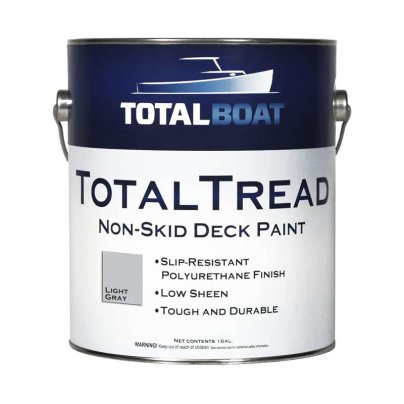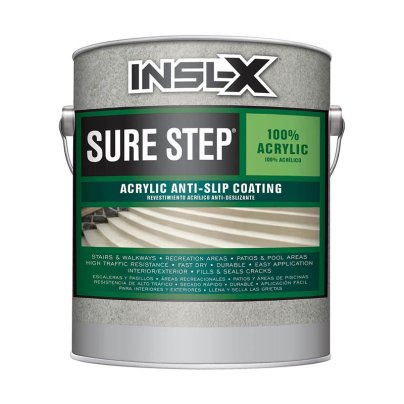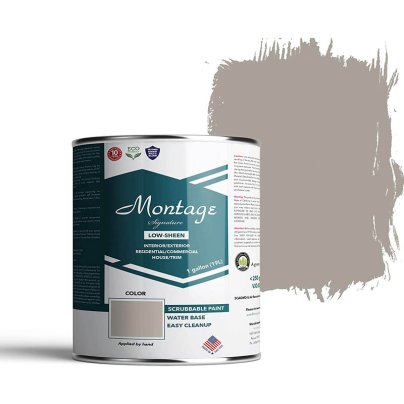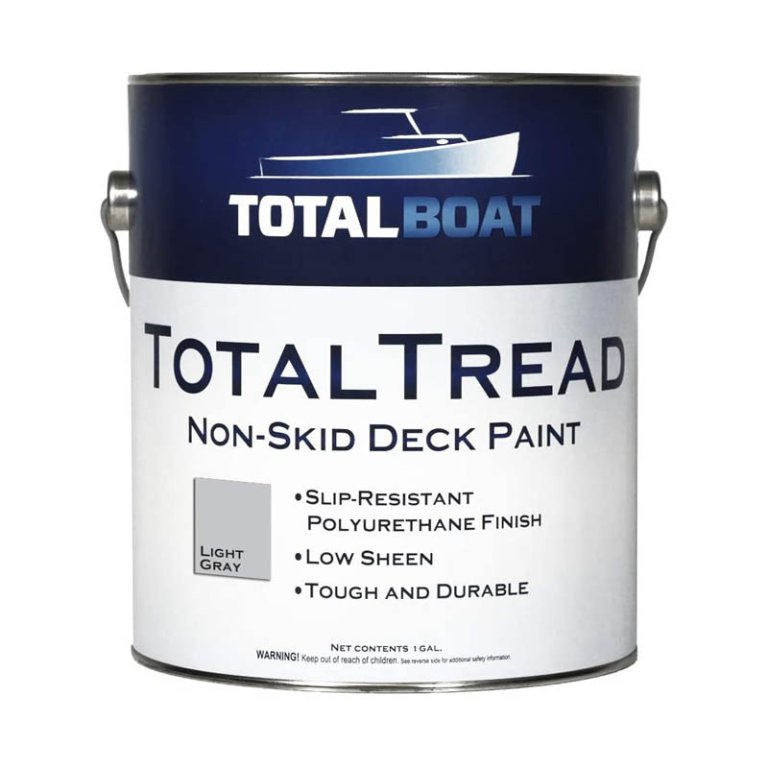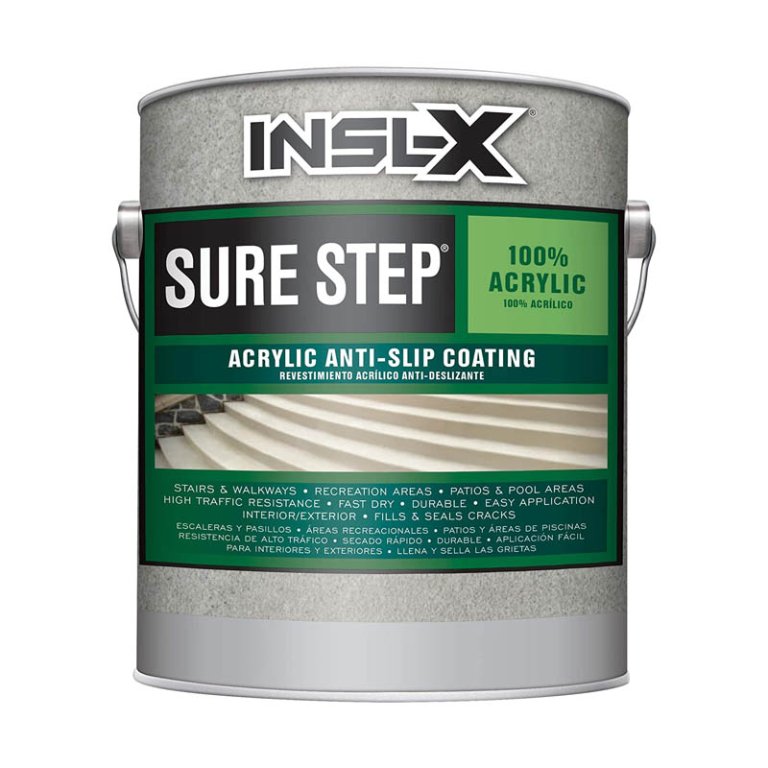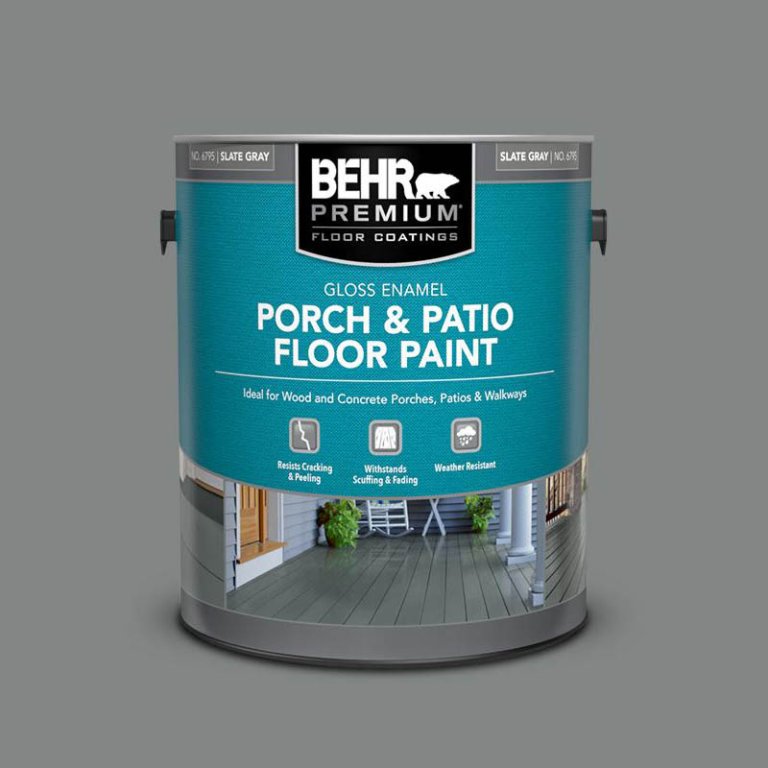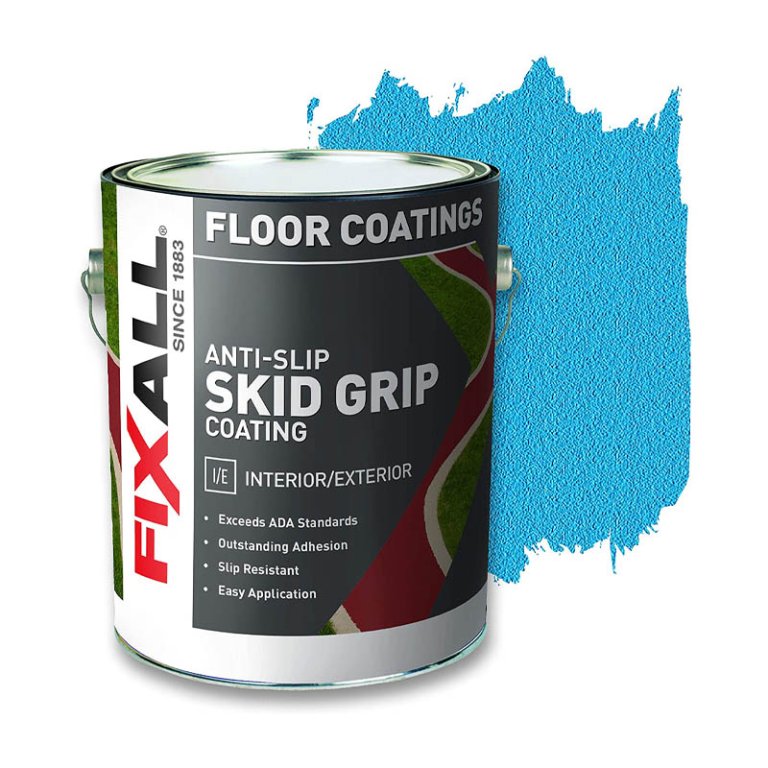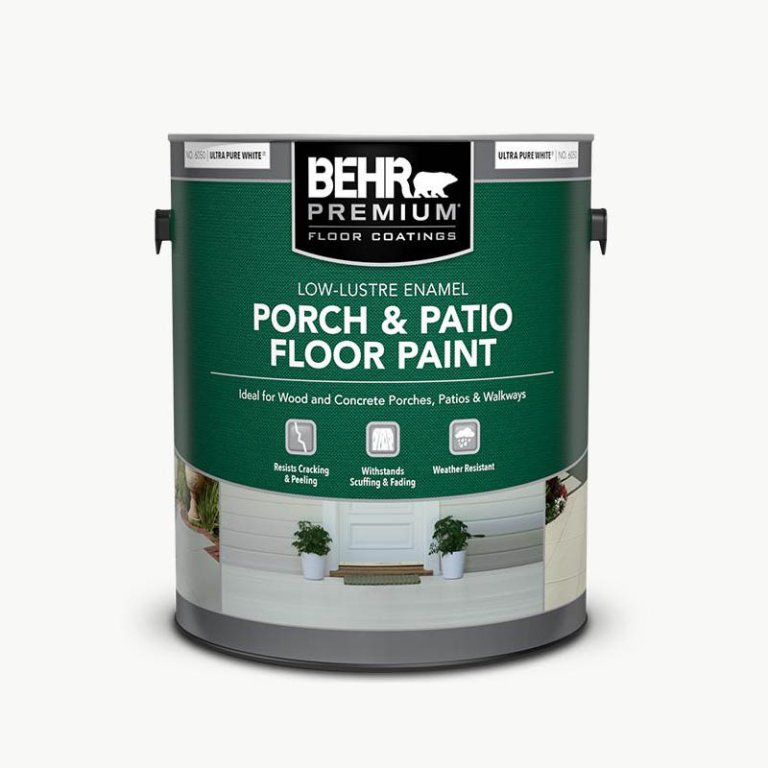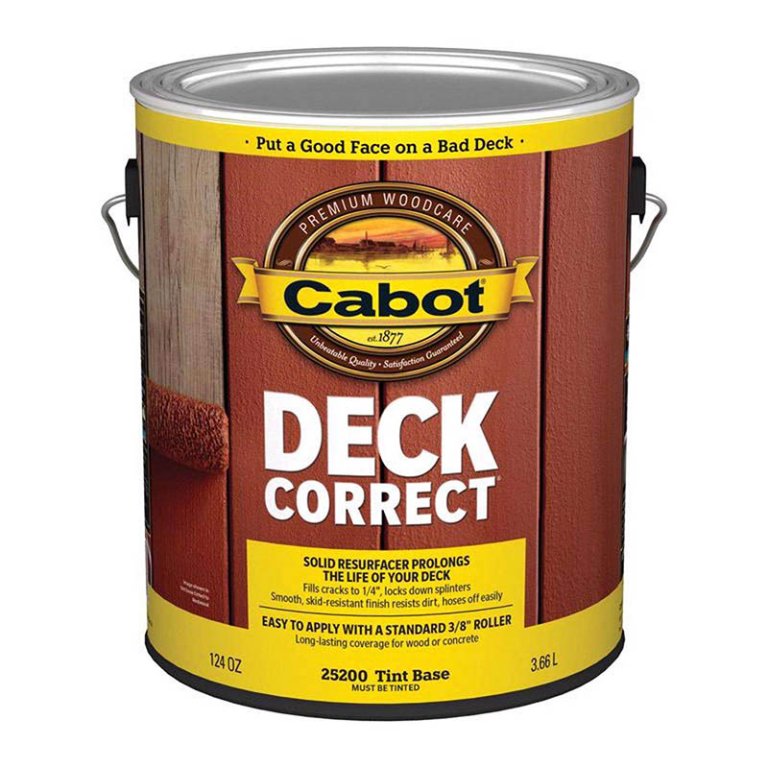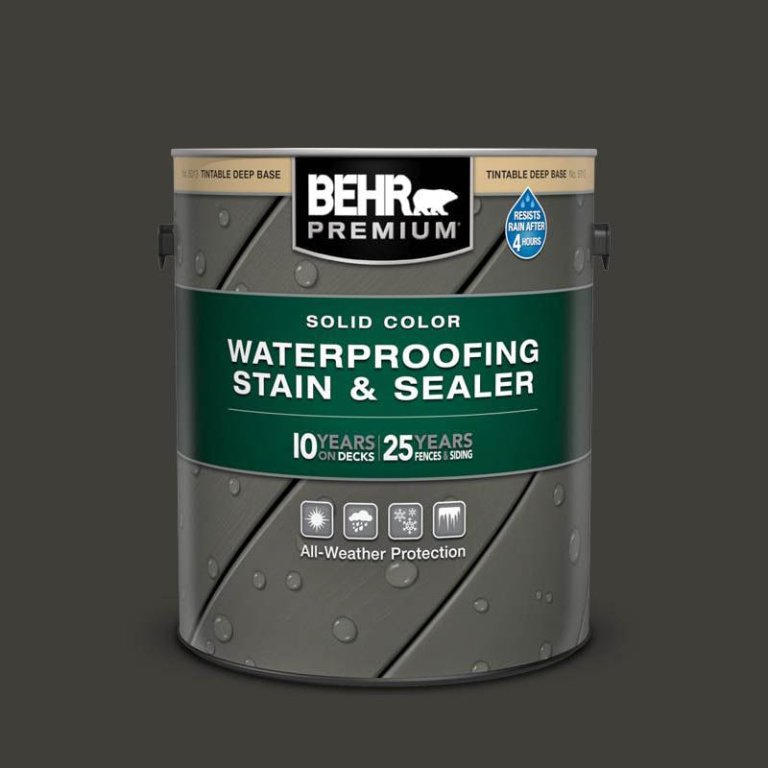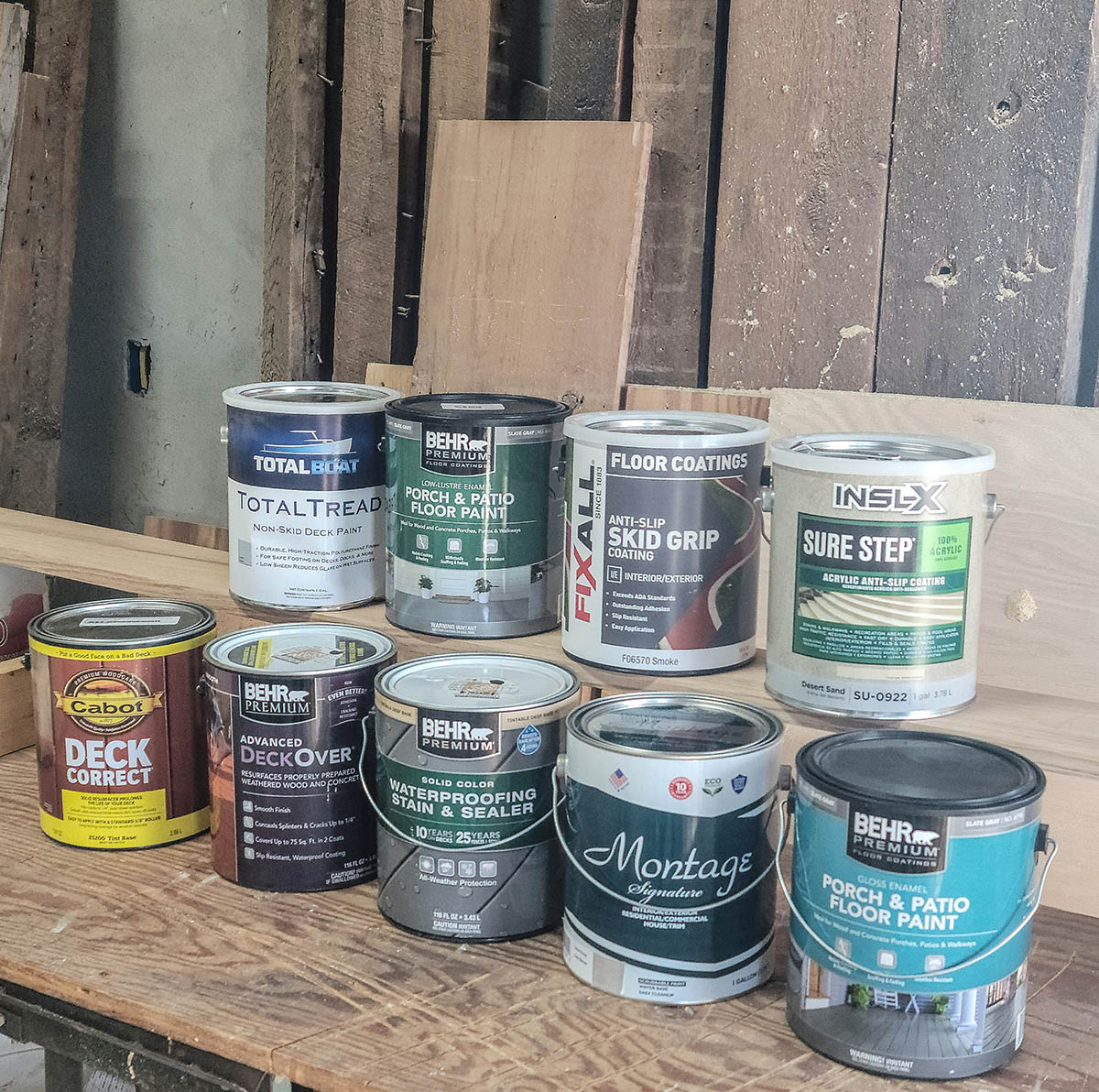
We may earn revenue from the products available on this page and participate in affiliate programs. Learn More ›
Decks extend the living area for personal downtime and festive gatherings, so they have to withstand a ton of traffic as well as take a beating from the elements. If you notice aged wood or peeling paint on your deck, it’s probably time for a fresh finish—the sooner, the better. Why? The longer you wait to paint the deck, the more flaws it can develop, making maintaining the deck that much more difficult.
However, getting the best results requires more than just grabbing the first gallon of deck paint you see at the home improvement store. To make an informed selection, you need to know what to look for in a deck paint. That’s why I decided to test the best brands on today’s market. Our top recommendation is the TotalBoat deck paint because of its smooth application and nonslip finish once fully dried.
I brushed on coat after coat of several different brands of deck paint on decking boards purchased specifically for the tests. I followed the application instructions for each and then took the test boards outdoors to face the harsh sun, rain, and wind before testing them further. Not all the deck paints I tried earned a spot in our lineup, but if you’re planning to update your deck, those that did are worth considering.
The best deck paint can stand up to harsh outdoor conditions, such as blowing dirt, wind, rain, and temperature extremes. Keep reading to learn how to choose the best deck paint, and see how each of the following products made it to this lineup.
- BEST OVERALL: TotalBoat TotalTread Non-Skid Marine Deck Paint
Jump to Review - BEST BANG FOR THE BUCK: INSL-X Sure Step Acrylic Anti-Slip Coating
Jump to Review - BEST FOR DECK RAIL: Montage Signature Interior/Exterior Paint
Jump to Review - BEST GLOSS FINISH: Behr Premium Gloss Enamel Porch & Patio Floor Paint
Jump to Review - BEST FOR POOL DECK: Fixall Skid Grip Anti-Slip Coating
Jump to Review - BEST COLOR SELECTION: Behr Premium Low-Lustre Porch & Patio Floor Paint
Jump to Review - BEST FOR OLD WOOD: Cabot DeckCorrect Water-Based Deck Resurfacer
Jump to Review - BEST QUICK-DRYING: Behr Premium Solid Color Waterproofing Wood Stain
Jump to Review
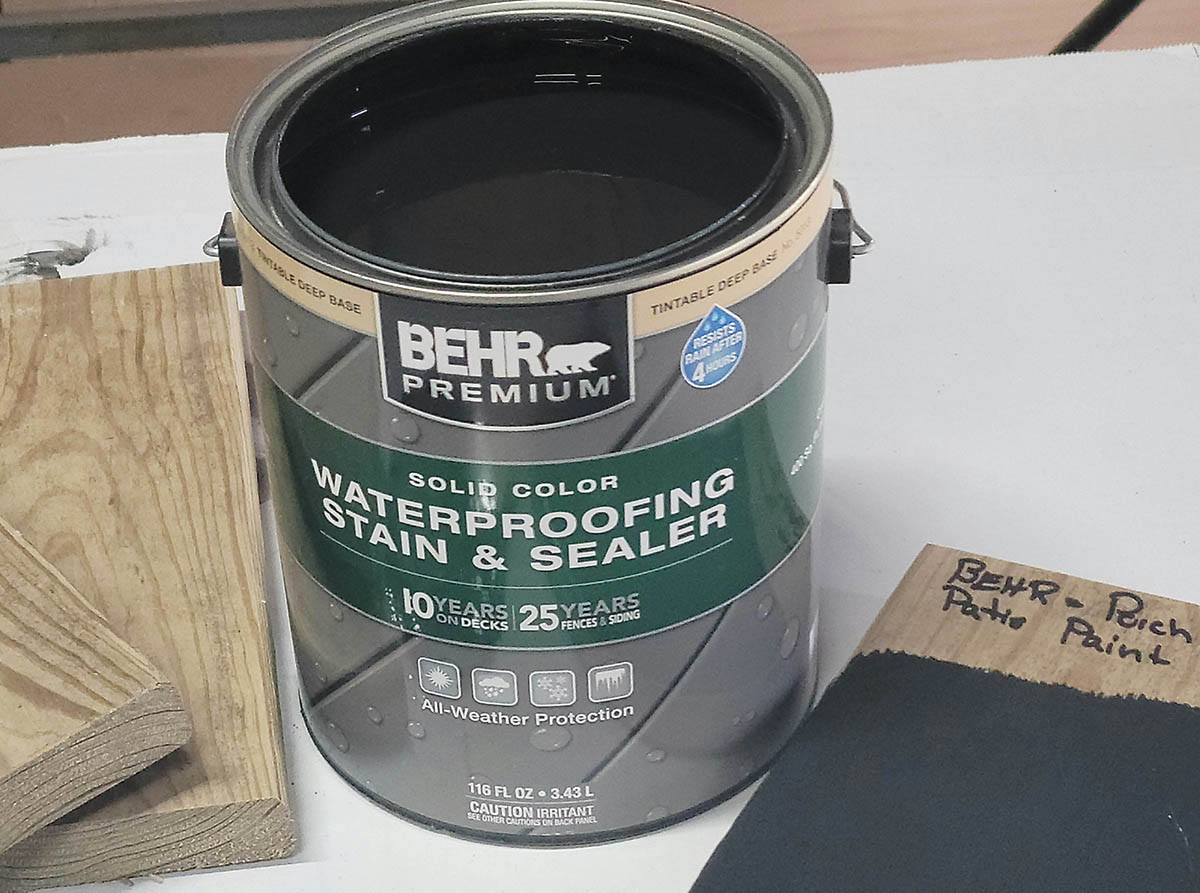
How We Tested the Best Deck Paints
When I started researching deck paints, I found a lot of hype and even more conflicting information and reviews, which led to the decision to test the most popular brands. I wanted to determine each one’s overall quality, so I started by purchasing decking planks and cutting them down to 12-inch test boards.
I labeled the test boards, and, except for one paint meant for pool decks, I applied the deck paints. I noted how well the paints were blended right out of the can and how long I had to stir them (if applicable). I also noted how evenly each paint covered when I brushed it on the surface of the test boards.
I added a second coat of each paint to ensure it had the best shot at adhering and forming a durable surface. Then, a couple of weeks after painting, I tested the painted surfaces by scrubbing them with a white rag to see if any color came off. I then checked to see how slick the surfaces were.
As I put the paints through their paces, I used a rubric and awarded points as to how well each performed on every test. At the end of the testing, I added the points and used them to help determine relevant awards for each product.
| Testing Stats | |
| Products tested | 9 |
| Time spent testing | 1 hour per paint, over several days |
| Tests performed | 5 to 6 |
| Price range | $30 to $120 |
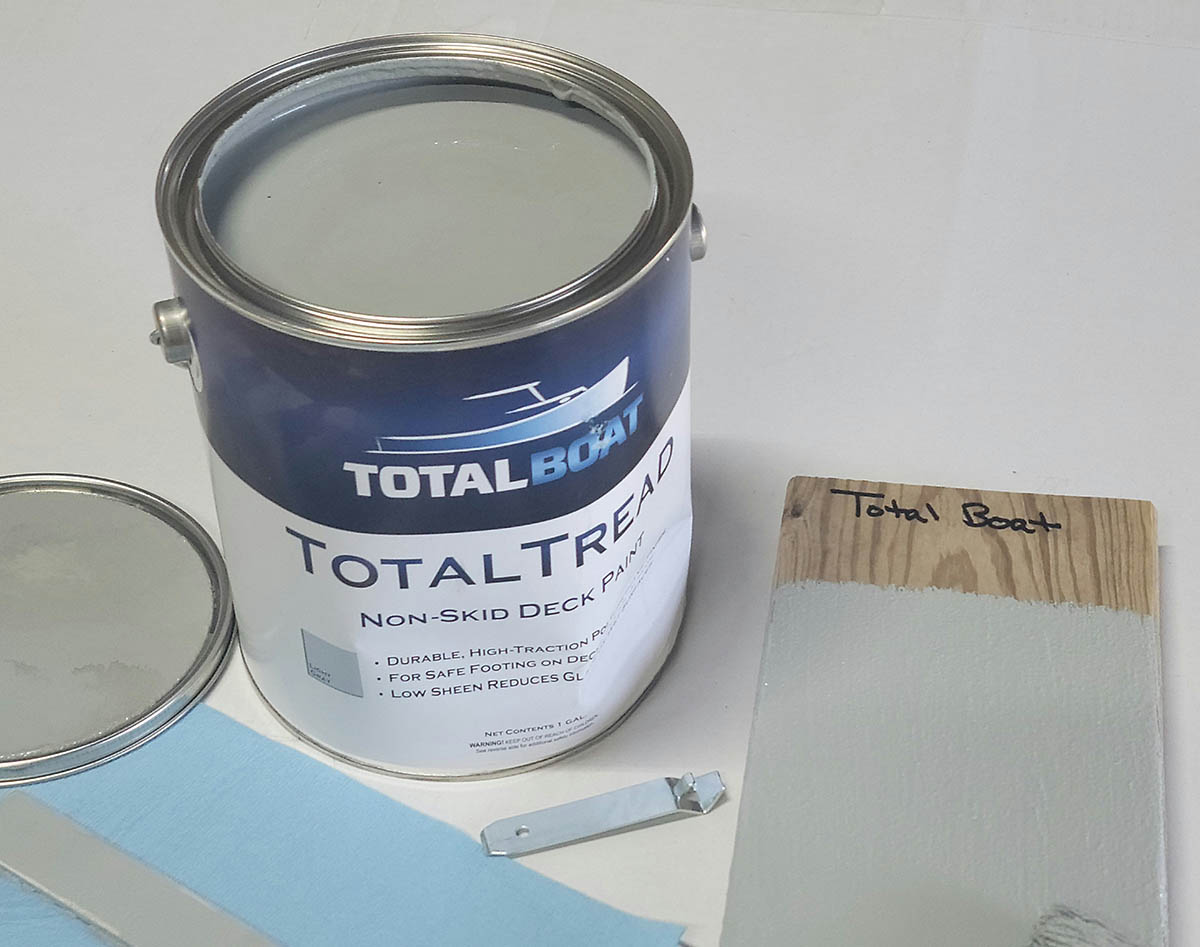
Our Top Picks
All the following products had to pass stringent testing to qualify for a spot in this lineup of the best deck paints. Because readers deserve to know how a deck paint is likely to perform before spending their money, I didn’t pull any punches.
It’s a waste of time and money to apply a substandard paint. If the paint fails, the paint must be scraped off and prepped again.
All the following deck paints are designed for various outdoor climates and needs, but each is a standout in its class. Check out each selection to learn its pros and cons before deciding which deck paint to use.
Best Overall
TotalBoat TotalTread Non-Skid Marine Deck Paint
Pros
- Goes on smoothly; each coat provides good coverage
- Blends easily and quickly; only a few minutes to mix
- Leaves a textured nonslip surface once fully dried
Cons
- Pricey compared to alternative options
Product Specs
- Suitable for: Wood, fiberglass, primed metals, previously painted surfaces
- Recommended coats: 1 to 2 coats
- Dry time between coats: Minimum of 16 hours
Our Ratings: Application 5/5; Odor 5/5; Finish 5/5; Durability 5/5; Value 4/5
For a fresh new look and anti-slip protection that lasts, consider TotalBoat TotalTread Non-Skid Deck Paint. It creates a rugged, textured surface suitable for decks, patios, and more.
This durable polyurethane deck paint is billed as tough enough to use on boat decks, and the manufacturer claims that it imparts a high-traction, low-sheen finish that won’t crack or peel. The paint came in a mid-tone gray, and it took no more than a couple of minutes to blend it with a paint stick. Excited to test those claims, I painted one of the decking test boards. It went on evenly with a brush. I set it aside to dry and added a second coat 16 hours later.
The next day, I put the painted test board outdoors to sit in the elements for 2 weeks. After that, I tested it for both scrubbability and nonslip properties. I sprayed the board with water and ran my fingers over it again—it wasn’t at all slippery. Then, I wiped the wet surface with a clean white rag to see if any color would come off on it. Nope. The rag was still white.
TotalBoat can be applied with either a brush or a roller, and one to two coats are recommended, although I thought a single coat covered very well. One gallon covers up to 300 feet. I like this paint a lot, but it’s not cheap. To cut costs when painting an entire deck, I’d use it only on the deck floor. I’d choose a less-expensive exterior enamel for railings since they don’t require a nonslip surface.
Get TotalBoat deck paint at Amazon or Jamestown Distributors.
Best Bang for the Buck
INSL-X Sure Step Acrylic Anti-Slip Coating
Pros
- Covers well and goes on evenly
- Provides a nonslip surface; ideal for decking that sees a lot of use
- Scrubbable; decking area can stay clean without needing repainted
Cons
- Paint separated in shipping and required lengthy stirring
Product Specs
- Suitable for: Wood, metal, masonry
- Recommended coats: 2
- Dry time between coats: Minimum of 8 hours
Our Ratings: Application 5/5; Odor 5/5; Finish 5/5; Durability 4.8/5; Value 4/5
Those looking to update a deck with a nonslip coating that doesn’t cost a fortune need look no further than INSL-X Sure Step Anti-Slip Coating. This acrylic deck and porch paint provides a high-traction surface at an affordable price. The paint is available in a handful of attractive colors, and I chose Desert Sand for my tests. One gallon covers up to 120 feet.
Since it had settled during shipping, I had to stir the paint for about 8 minutes before it was blended well enough to continue. I used a brush and applied a coat to my test board. It went on evenly and covered well. I could see a fine texture, and I set it aside to dry.
After 8 hours (the recommended minimum wait time), I applied a second coat, brushing it perpendicular to the first, as instructed on the label. I could see a potential benefit to cross-brushing the second coat—it might adhere better than if brushed in the same direction. That was the first time I’d run across the technique, but I’ll keep it in mind for future painting projects. Plus, INSL-X is made by Benjamin Moore, one of the most respected paint manufacturers in the nation, and I usually trust the company’s advice.
When the paint was dry, I tested INSL-X’s nonslip texture by wetting and rubbing my fingers over the wet surface—they did not slide easily. I tested scrubbability by spraying the decking board with water and rubbing it with a clean white rag. No color came off on my rag, so that was a plus. Only time will tell how any decking paint holds up to months of UV rays and the elements, but my initial opinion of INSL-X is that it offers a durable, nonslip surface at an attractive price point.
Get INSL-X deck paint at Amazon, The Home Depot, or Ace Hardware.
Best for Deck Rail
Montage Signature Interior/Exterior Paint
Pros
- Made using an environmentally friendly formula
- Resists mold and mildew; perfect for outdoor weather
- Water based; cleans easily with soapy water
- Durable and scrubbable; holds up to heavy use
Cons
- Strong odor while painting until fully dried
- Not suitable for deck floors; rails only
Product Specs
- Suitable for: Wood, masonry
- Recommended coats: 1 to 2
- Dry time between coats: Minimum of 4 hours
Our Ratings: Application 5/5; Odor 3/5; Finish 5/5; Durability 5/5; Value 4/5
In the past, I wasn’t entirely sold on environmentally friendly paints: either they didn’t offer good coverage, or they didn’t stand up to the elements. I’m happy to say that Montage Signature made me rethink my opinion. This is the first environmentally responsible paint I’ve used that offers resistance to mold, mildew, and UV rays. One essential note, however: It should be used only on deck railings or built-in benches, not on deck floors, because it’s not designed to withstand foot traffic.
This water-based paint is a low-VOC product and free of toxic fumes, but the smell still isn’t appealing—it borders on disgusting. However, I applied most of these paints in a shop to decking boards. Had I been painting actual deck railing, I would have been outdoors, so the odor would have been less noticeable. The best thing I can compare the smell to is rotting leaves. Fortunately, when the paint is dry, no odor lingers.
Montage Signature is suitable for use on indoor or outdoor railings and trim. It’s available in either semi-gloss or low-luster sheens and comes in 18 gray and earth tones. I selected light gray in a low luster, and I was impressed with the color and the uniform coverage. I applied a second coat after waiting the recommended 4 hours.
Like the other paints I tested, I put Montage Signature to the scrub test after the decking board sat for 2 weeks outdoors. I sprayed on water and wiped vigorously with my rag; no paint came off. One gallon of this eco-friendly paint can cover up to 300 square feet. With this product, cleanup is with soap and water.
Best Gloss Finish
Behr Premium Gloss Enamel Porch & Patio Floor Paint
Pros
- Goes on smoothly and uniformly; easy to apply
- Levels out for a sleek and professional appearance
- Dries to a hard and durable finish
Cons
- No nonslip texture; wet days may be slippery
Product Specs
- Suitable for: Wood and masonry
- Recommended coats: Not specified (I prefer 2 coats)
- Dry time between coats: No minimum time listed; 72 hours for full cure
Our Ratings: Application 5/5; Odor 5/5; Finish 4/5; Durability 5/5; Value 4/5
Update that deck with a gloss finish with Behr Premium Gloss Enamel Porch & Patio Floor Paint. This enamel deck paint provides a polished sheen that could dress up any deck. I tested this deck paint in Slate Gray.
The paint was mixed relatively well when I opened the can, so I only had to stir it for a minute or so. I used a brush to apply a uniform coat on my test board, and it went on smoothly and evenly. The label doesn’t specify the need for a second coat or offer a minimum drying time between coats. It does, however, suggest waiting 72 hours for the paint to cure. I felt that the initial coat was too thin, so I waited the full 72 hours and then brushed on a second coat.
Behr Premium Gloss dried to a fine sheen—not as glossy as some paints I’ve used, but definitely in the gloss category. The tone was pleasing, and I could imagine it on a larger deck area. I set the board outdoors to await the 2-week scrubbability test. It came through with flying honors: No color or paint came off on my white rag. However, when I wet the test board and rubbed my finger across the paint, I felt little-to-no friction, which makes me think that this paint would be slippery when wet.
One gallon covers up to 400 square feet on wood or masonry, and because it’s a water-based paint, cleanup requires just soap and water. I really like the look and durability of Behr Premium Gloss paint. However, for those looking for a nonslip tread, a different option might provide a safer surface.
Get Behr gloss deck paint at The Home Depot.
Best for Pool Deck
Fixall Skid Grip Anti-Slip Coating
Pros
- Goes on thick and smooth; may require just a few coats
- Creates a safe, nonslip surface; great for wet areas
- Durable and scrubbable surface provides longevity
Cons
- Low coverage; large areas will require several cans
- Surface might feel rough on bare feet
Product Specs
- Suitable for: Concrete, brick, asphalt
- Recommended coats: 2
- Dry time between coats: Minimum of 12 hours
Our Ratings: Application 4/5; Odor 5/5; Finish 5/5; Durability 5/5; Value 4.8/5
Nonslip safety is a top concern around pools, and Fixall Skid Grip Anti-Slip Coating produces a textured, high-traction flat finish on wood, stone, and concrete. Moreover, it exceeds the Americans with Disabilities Act (ADA) standards for anti-slip surfaces. This water-based paint is available in a range of attractive colors that complement landscape decor, and the coating resists fading, chipping, and peeling.
This was the only deck paint I tested on a concrete paver instead of a decking board because it’s used for pool decks, which are typically (but not always) concrete or brick. It’s also recommended for both concrete and asphalt tennis courts, driveways, and sidewalks. The paint is available in a handful of colors, and I chose Smoke.
As far as I could tell, the paint hadn’t separated, but I gave it a few stirs to be on the safe side. I painted the top of a concrete paver with a brush. The paint is thick but easy to smooth out. A single coat might have been sufficient, but two are suggested, so I waited the recommended 12 hours and applied a second coat.
The Fixall paint left a noticeably textured surface that felt slightly rough to my bare fingers when fully dry. After 2 weeks, I wet it down, and the friction was excellent! My fingers didn’t slip at all. A slight downside is that the surface is scratchy, and I imagine it could be rough on bare feet. The nonslip safety factor, however, is excellent. It also excelled in my scrubbability test.
Fixall paint offers superior adhesion and can be applied with either a brush or a roller. Cleanup is simple with warm, soapy water. One gallon covers up to 80 square feet.
Best Color Selection
Behr Premium Low-Lustre Porch & Patio Floor Paint
Pros
- Goes on evenly and blends well when first opened
- Brush marks fade for a smooth and professional finish
- Can be custom-tinted to any shade to match existing decor
Cons
- Likely slippery when wet; not ideal around pool areas
Product Specs
- Suitable for: Wood, concrete
- Recommended coats: The manufacturer doesn’t specify (I prefer 2 coats)
- Dry time between coats: No minimum time listed; 72 hours for full cure
Our Ratings: Application 4.5/5; Odor 5/5; Finish 4.5/5; Durability 4.5/5; Value 4/5
Choose pure white, or have Behr Premium Low-Lustre Enamel Porch & Patio Floor Paint custom-tinted to any desired color via Behr’s computerized color-matching system. Behr is sold only at The Home Depot, but users can order online after browsing the color swatches at the store.
The paint is also available in either gloss or low luster, and I chose low luster. I bought the paint at the local Home Depot, and they shook it in their machine. It was blended well when I opened it, and no stirring was necessary. I applied a uniform coat to my test board with a brush, and it covered evenly. The brush marks leveled out to a flat finish, but I felt like a single coat was too thin. After 72 hours, I applied a second coat, even though the label’s instructions didn’t suggest it. It also didn’t mention a minimum recoat time. However, at 72 hours, the paint was supposed to be fully cured, so that’s when I applied a second coat.
Two weeks later, I tested the paint for nonslip attributes and scrubbability. It passed the scrubbability test, but it didn’t exhibit any nonslip properties. My fingers slid across easily when the surface was wet, so keep that in mind if looking for deck paint that deters slipping.
One gallon of this enamel is supposed to cover up to 400 square feet, but I suspect that’s only when a single, thin coat is applied. Still, it offers an attractive finish that users can have custom-blended to the color of their choice, and it’s made to resist mildew growth.
Get Behr low-luster deck paint at The Home Depot.
Best for Old Wood
Cabot DeckCorrect Water-Based Deck Resurfacer
Pros
- Fills in small cracks; great for renewing older decks
- Goes on smoothly for an even finish
- Provides nonslip surface; suitable for most outdoor areas
Cons
- Low coverage at just 75 square feet per gallon
- Took longer than advertised to dry
Product Specs
- Suitable for: Wood
- Recommended coats: 2
- Dry time between coats: 4 to 6 hours (it took 24 hours before the first coat wasn’t tacky)
Our Ratings: Application 4.5/5; Odor 5/5; Finish 5/5; Durability 5/5; Value 4.8/5
To test Cabot DeckCorrect, I selected a board with knots and a few minor splits. DeckCorrect is not only designed to provide a nonslip finish, but it’s also supposed to fill in small cracks and flaws in wood. The paint comes in a satin tint base, and I had it tinted Slate Gray at my local Lowe’s.
The formula is fairly thick, and the first coat seemed to fill most of the small cracks and cover the depression made by the knot—but not completely. The manufacturer suggested a second coat after 4 to 6 hours, but I had to wait nearly 24 hours before the surface was no longer tacky to recoat it. The second coat completely filled in the cracks and the knot; I could no longer see or feel them.
After 2 weeks, I tested for scrubbability and to determine if the surface was nonslip. Cabot DeckCorrect passed both tests: My fingers didn’t slide on the wet board, and no paint came off on my rag. One gallon covers up to 75 square feet, and cleanup is easy with warm, soapy water.
Best Quick-Drying
Behr Premium Solid Color Waterproofing Wood Stain
Pros
- Goes on evenly and offers waterproofing and UV blocking
- Can be recoated in just 1 to 2 hours; great for quick paint projects
- Dries to an attractive low-luster finish
Cons
- Not nonslip; may not be suitable around wet areas
- May need more than 2 coats for the best coverage
Product Specs
- Suitable for: Wood, composite decking
- Recommended coats: 2 (more might be beneficial)
- Dry time between coats: 1 to 2 hours
Our Ratings: Application 4.5/5; Odor 5/5; Finish 4/5; Durability 5/5; Value 4/5
For fast drying and speedy recoating, consider this Behr Premium solid color waterproofing paint. While technically a stain, this deck coating imparts a solid opaque color, creating a full-coverage coating like deck paint. I chose an attractive Slate Gray color.
Having tested many deck paints, I was skeptical that this Behr paint would be dry enough to recoat in 1 to 2 hours, but I was wrong. The formula is relatively thin, and it partially penetrated the wood, although it still obscured the wood grain. It’s like a cross between a stain and an enamel. The main difference is that a true stain cannot be applied over a previously painted surface, but this solid color stain/sealer can, placing it in both the stain and paint categories.
It was dry to the touch at 2 hours, so I applied the second coat, which added thickness and just a soft hint of sheen. I felt it could have benefited from a third coat, but I didn’t apply one since I used two coats to test all the products. It’s an attractive finish that should complement most outdoor settings.
After 2 weeks, the color didn’t come off when I scrubbed the board with my rag, but it didn’t impart a nonslip surface either. It wasn’t as slick as some of the other products that didn’t offer nonslip properties, but it was still on the slick side.
This Behr Premium formula is suitable for composite and wood decks. It offers waterproof protection and contains UV blockers to prevent fading. The water-based paint also contains a mildewcide for added protection against mold and mildew. Apply it with a brush, roller, or sprayer. One gallon covers up to 400 square feet.
Get Behr deck paint at The Home Depot.
ALSO TESTED
Behr Premium Advanced DeckOver Waterproof Coating
I was disappointed at having to disqualify Behr Premium Advanced DeckOver from this lineup. In the early phase of the testing, I was impressed with DeckOver—it went on smoothly, the color I’d chosen—a deep gray—was pleasing, and it provided a nice, nonslip finish.
The problem came two weeks later after I’d left the decking board out in the harsh sun and elements before testing it for scrubbability. As with the other test boards, I sprayed the DeckOver test board with water and then rubbed it with a clean white cloth. The gray color came off on my rag. Behr claims the paint is fully cured in 72 hours, so it wasn’t an issue with the paint not curing.
I examined the board carefully, and with a fingernail, I picked gently at a loose edge of the painted surface. I was able to lift a section of the dried DeckOver paint and peel it off. At that point, I had no other option; I had to disqualify the paint from the lineup.
I can’t be sure whether I purchased an old can of paint that had been sitting on a shelf somewhere or if it had been exposed to extreme temps that damaged it. I just knew that it didn’t live up to our high standards.
Jump to Our Top Picks
What to Consider When Choosing the Best Deck Paint
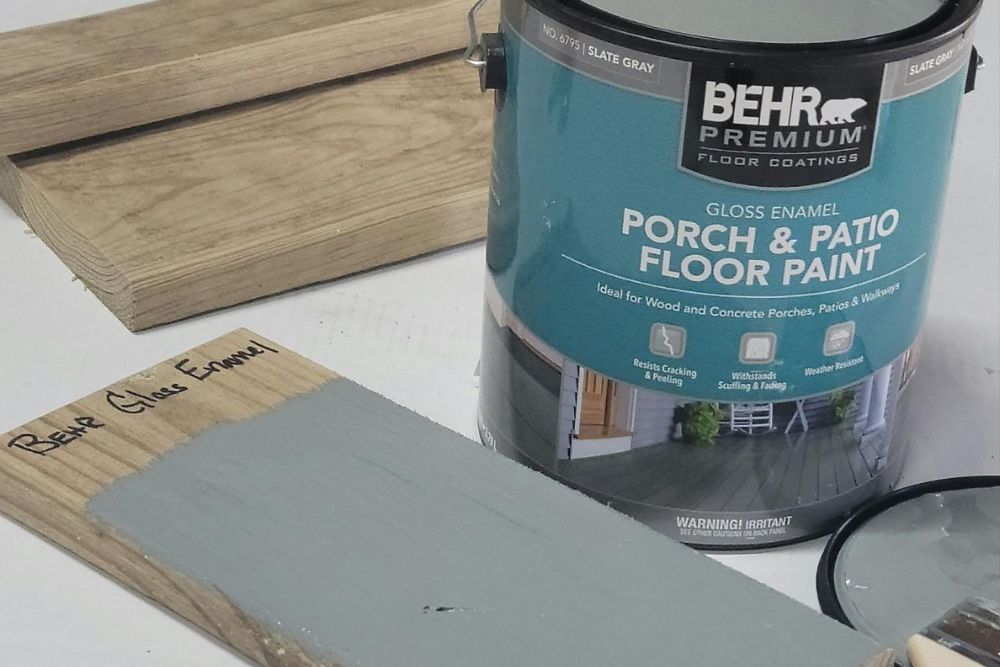
Choosing a wood deck paint is about more than just buying exterior paint and rolling it on. According to Jolene Jantz, paint adviser for Jantz Lumber and Do it Center in McPherson, Kansas, DIYers should first make sure the paint is meant for horizontal surfaces.
Jantz explains that many exterior paints and enamels can withstand the elements—when applied to vertical surfaces. Deck paint must be made specifically to apply to horizontal surfaces. “The can should say that the paint is made for horizontal surfaces if it’s suitable for use on a deck,” Jantz said.
Additional considerations include the type of wood, the kind of prep work required before painting, and the desired look of the finished project.
Base
Deck paint comes in two main types: oil-based and water-based, each of which has advantages and disadvantages. While oil-based paints once ruled the market, water-based products are in greater demand today because of their improved durability and ease of use.
Oil-based deck paint has been around for decades, and until the past decade or so, it was considered the best paint for decks and other exterior projects. These paints are still a durable and affordable option, but they also have some less desirable features. An oil-based wood deck paint:
- Provides a tough, durable finish;
- Can last 5 to 10 years, depending on wood condition and paint quality
- Provides optimal moisture protection;
- Is available in a range of colors;
- Is high in volatile organic compounds (VOCs), which create fumes that can lead to watery eyes, a sore throat, or other respiratory issues;
- Requires the use of a solvent, such as paint thinner or turpentine, to clean brushes, rollers, and sprayers; and
- Can take up to 24 hours to dry sufficiently, although some oil-based paints now contain quick-drying additives that allow recoating in 6 to 8 hours.
Water-based deck paint, including acrylic paint and latex paint, has come a long way in recent years. In fact, many experts consider it just as good as oil-based paints. Today these paints are available in a variety of colors and optional ingredients that help protect exterior wood. A water-based wood deck paint:
- Is low in VOCs;
- Can last 4 to 8 years, depending on wood condition and paint quality
- Offers the best protection against fading;
- Cracks and peels less because its acrylic ingredients are flexible;
- Cleans up with just soap and water;
- Dries quickly and is ready to recoat in 4 to 6 hours; and
- Is available in a range of colors.
VOC Content
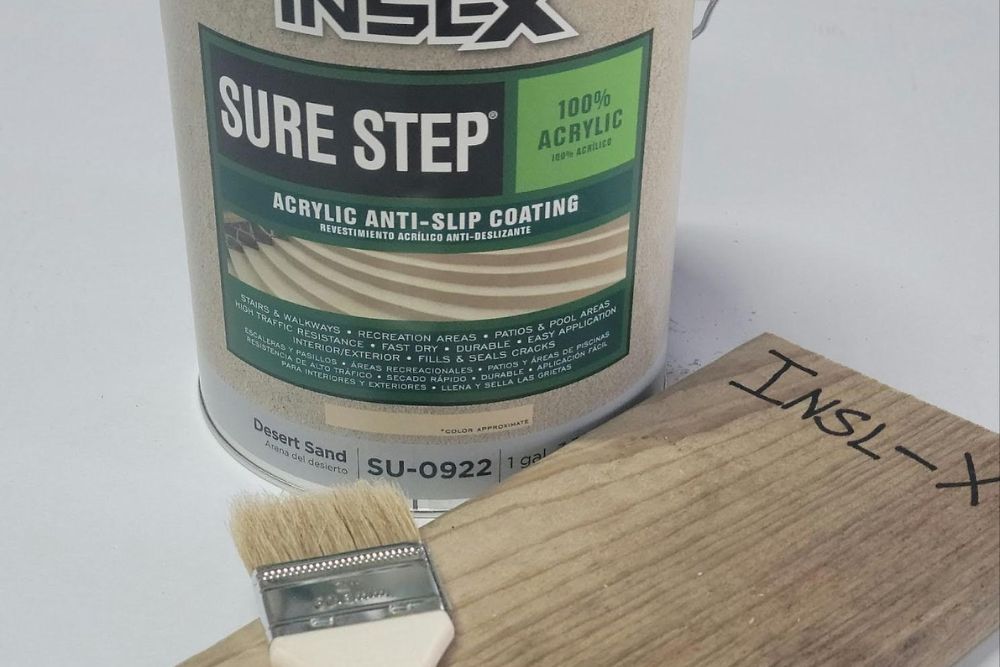
Many of today’s consumers want to use fewer toxic products. In response, paint manufacturers are finding ways to manufacture quality paints with lower volatile organic chemicals (VOCs), which are the harmful gases emitted by these products. Some may cause health problems. Deck paint with lower VOC content is labeled as either “Low-VOC” or “Zero-VOC.”
- Low-VOC: Paints bearing the “Low-VOC” label should contain less than 50 grams per liter (g/L) of VOCs if the paint has a flat finish and no more than 110 g/L if the paint features a sheen, such as gloss or semi-gloss.
- Zero-VOC: Also called “No-VOC,” paint labeled “Zero-VOC” contains minimal volatile organic chemicals—or none at all. A Zero-VOC deck paint may still have trace amounts of VOCs, but no more than 5 g/L. Individuals who are sensitive to the fumes from higher VOC paints likely prefer these paints.
Wood Type
Some wood species, such as redwood and cedar, are naturally resistant to moisture damage, rot, and insect infestations, but they’re typically pricey. As a result, most exterior decks are constructed from treated lumber. This wood, usually yellow pine or Douglas fir, is infused under pressure with alkaline copper quaternary (ACQ) to resist the elements. However, when it reaches the lumberyard, this popular lumber is often newly treated, and the ACQ chemicals haven’t had time to evaporate out of the wood.
Before painting a new treated-wood deck, experts recommend waiting at least 6 months to ensure these chemicals have evaporated completely. If you paint a deck before the chemicals evaporate, the paint may not adhere, resulting in cracking and peeling.
Durability
To stand up to the elements, the deck paint must be labeled “exterior paint” to help ensure its suitability for outdoor use. Steer clear of interior paints, which don’t have adequate weather- and fade-resistant qualities.
The adage “You get what you pay for” is true with paint. The best deck paints contain better binding agents and longer-lasting pigments, such as titanium dioxide, that make the color less likely to fade or peel.
Manufacturers often produce paint in three categories: “Good,” “Better,” and “Best.” Products labeled “Best” may cost twice as much as those in the “Good” lineup, but they are more durable. Higher quality paints are also thicker, which means a gallon of “Good” paint will cover more square feet than a gallon of “Best” paint. “Best” paint can leave a thicker, more durable coating on the deck. The general rule is to buy the highest quality paint available, because it will last longer and protect the wood more efficiently.
Look for these qualities:
- 100 percent acrylic: Top-of-the-line water-based deck paints often contain all-acrylic binders, making them slightly flexible and less likely to peel.
- Polyurethane (PU): Like acrylic paint, polyurethane-based paints are durable and provide a weather-resistant coating. Marine paint is typically this type.
- Drying oils: In oil-based paints, the inclusion of drying oils, such as linseed oil or modified oil, indicates the paint will go on evenly and dry to a hard, durable finish.
- UV blockers: Both oil-based and water-based paints will last longer if they contain UV blockers that protect them from damaging UV rays.
- Mildewcide: When painting a deck in a humid region, look for the addition of mildewcide to help reduce the risk of mold or mildew growth on the deck.
Climate Conditions
Because they’re intended for exterior use, most deck paints contain additives to protect the deck from mold, mildew, UV rays, and extreme temperatures. While paints with one or two of these additives are typically OK, it’s often a good idea to opt for a product with all three for the best protection and longest-lasting color.
Wet and rainy climates contribute to deck paint failure, because if moisture seeps into the wood beneath the paint, it can loosen the bond between wood and paint, resulting in peeling. To reduce this risk, paint all sides of the deck boards—even the bottom, if possible—to seal the wood and keep out moisture. If the deck sits low to the ground, making it impossible to paint the underside, consider using a penetrating deck stain rather than a deck paint. When choosing between paint or stain, remember that stain will seep into the wood grain itself.
Lasting Color
Both oil-finish and high-quality water-based deck paints resist fading, but deep colors and bright tones usually fade more quickly than light hues and earthy tones. Dark, bright colors require a higher percentage of pigments to bring out the color. Adding higher levels of pigment can reduce the quality of the main ingredients because they’re more diluted. Paint manufacturers constantly work to improve color durability, and today’s paints are more colorfast than their predecessors.
When choosing a color, also consider the deck’s location. A deck that’s frequently in the sun will fade more quickly than a deck in deep shade, even if the paint contains UV protection.
Texture and Finish
Deck paint is available in different surface finishes, depending on the percentage of gloss ingredients in the formula.
- Flat: Deck paint with a flat finish has no sheen at all, so it helps hide flaws, such as gouges or splits in the wood. However, dirt is more likely to stick to a flat finish, making flat paint better suited to decks that won’t see a lot of muddy traffic.
- Eggshell: Eggshell deck paint, which has a slight sheen of about 10 percent, provides a nice, soft finish. The low level of shine also helps hide flaws in the wood. Dirt often collects on an eggshell surface, making it more suitable for enclosed decks.
- Satin: Also called “low luster,” satin is a popular choice for outdoor decks because it offers a muted sheen (about 30 percent), yet it still hides many flaws and allows dirt and dust removal by simply sweeping.
- Semi-gloss: Semi-gloss (also called “enamel”) paint provides about 70 percent sheen with a surface that’s easy to sweep and wipe away spills. This is the most commonly used finish for exterior trim work, doors, and shutters, so choose semi-gloss to match trim.
- High gloss: High gloss is easy to keep clean. Dust and dirt blow right off, and spills are easy to wipe up. However, with about 85 percent shine, this finish can highlight flaws in woodwork. Every nail hole and chunk of missing wood will show, so it’s a better choice for newly built decks.
Decks, steps, and porches often get wet and slick in inclement weather, especially if they surround a swimming pool or are otherwise exposed to the elements. In addition to selecting a color, consider nonslip paint. Many deck paints contain ingredients, such as fine silica sand, that create a slightly textured surface to increase traction and reduce the risk of slipping.
Dry Time
Most oil-based deck paints take longer to dry than water-based options, which can take as long as 6 to 24 hours, depending on the product. Water-based paints dry more quickly, some as quickly as in 1 to 2 hours. However, temperature and humidity affect the dry times of both types of paint.
Many deck paint manufacturers suggest applying paint when the outdoor temperature is over 50 degrees Fahrenheit but no higher than 80 degrees Fahrenheit. Temperatures lower than 50 degrees can cause either type of paint to dry more slowly. In temperatures higher than 80 degrees, especially on a dry, sunny day, the paint may dry too quickly, which means the ingredients won’t bind as well as they should, reducing the quality and endurance of the paint.
Recoating time is slightly longer than drying time. In general, allow an additional 24 hours after oil-based paint dries before recoating, and allow 4 hours after water-based paint dries before applying a second coat.
Prep and Application
For quality results, readying a deck for painting is essential. According to Jantz, “It’s the single most important part of learning how to paint a deck.” Prepping involves the following steps:
- Clean the deck: Use a deck-cleaning solution designed to dissolve dirt, grease, and grime. If using a power washer, adjust it to the lowest pressure setting to avoid digging out chunks of wood.
- Remove loose paint: If paint is loose or peeling from a previous paint job, remove it with a paint scraper to ensure new paint will adhere to the surface. Not all of the old paint needs to be removed, just the loose flakes.
- Make repairs: Replace loose or damaged boards before painting.
- Sand: For the smoothest finish, sand the entire deck before painting. Hand-sanding is fine, but a power sander speeds up the task.
- Apply paint to a dry deck: Paint doesn’t adhere well to damp wood, so let the deck dry completely before painting. Some deck paints can be applied with a roller, brush, or sprayer; however, don’t use a sprayer with anti-slip deck paints because of their textured ingredients.
- Prime: In both previously painted and new decks, first apply a primer so the new paint will adhere better.
FAQs
With the cost of construction materials at an all-time high, it pays to protect a backyard deck to gain as much useful life from it as possible. A fresh coat of paint can help safeguard wood decks from UV damage, mildew, and water rot, but for those new to the idea of painting a deck, some questions are to be expected.
If you’ve previously painted the deck, it’s best to repaint. For a new deck or an older deck that you’ve never painted, you can either stain or paint it.
You’ll need to reapply deck stain every few years. Deck paint can last up to 7 years before reapplication is needed, depending on paint quality and the wood’s condition.
Ultimately, longevity depends on the quality of the paint and the condition of the deck. However, in general, expect deck paint to last 4 to 7 years.
Meet the Tester
Glenda Taylor is a product tester and writer specializing in the construction, remodeling, and real estate industries. She and her husband own a general contracting company, and Taylor is experienced in both residential and commercial building applications. She tests a wide range of power tools as well as other home improvement, household, and lawn-and-garden products.
